Business Environment Analysis: Tesco and Business Functions
VerifiedAdded on 2023/01/19
|19
|5096
|26
Report
AI Summary
This report provides a comprehensive analysis of the business environment, primarily focusing on Tesco, a prominent private sector organization, alongside discussions on public and voluntary sector organizations. It delves into the varied types of organizations, their purposes, and legal structures, examining their size and scope. The report explores the interrelationships between different business functions and how they contribute to organizational structuring and functioning. Furthermore, it assesses the benefits and drawbacks of the macro environment on business activities, utilizing PESTLE and SWOT analyses to evaluate both public and private sector organizations. The interrelationship of external business factors with company strengths and weaknesses is also examined, providing a holistic view of the business environment and its impact on organizational strategy and performance. The report is structured to provide insights into the operations of Tesco, NHS and Oxfam, and offers a detailed understanding of the factors influencing their success within the business environment.
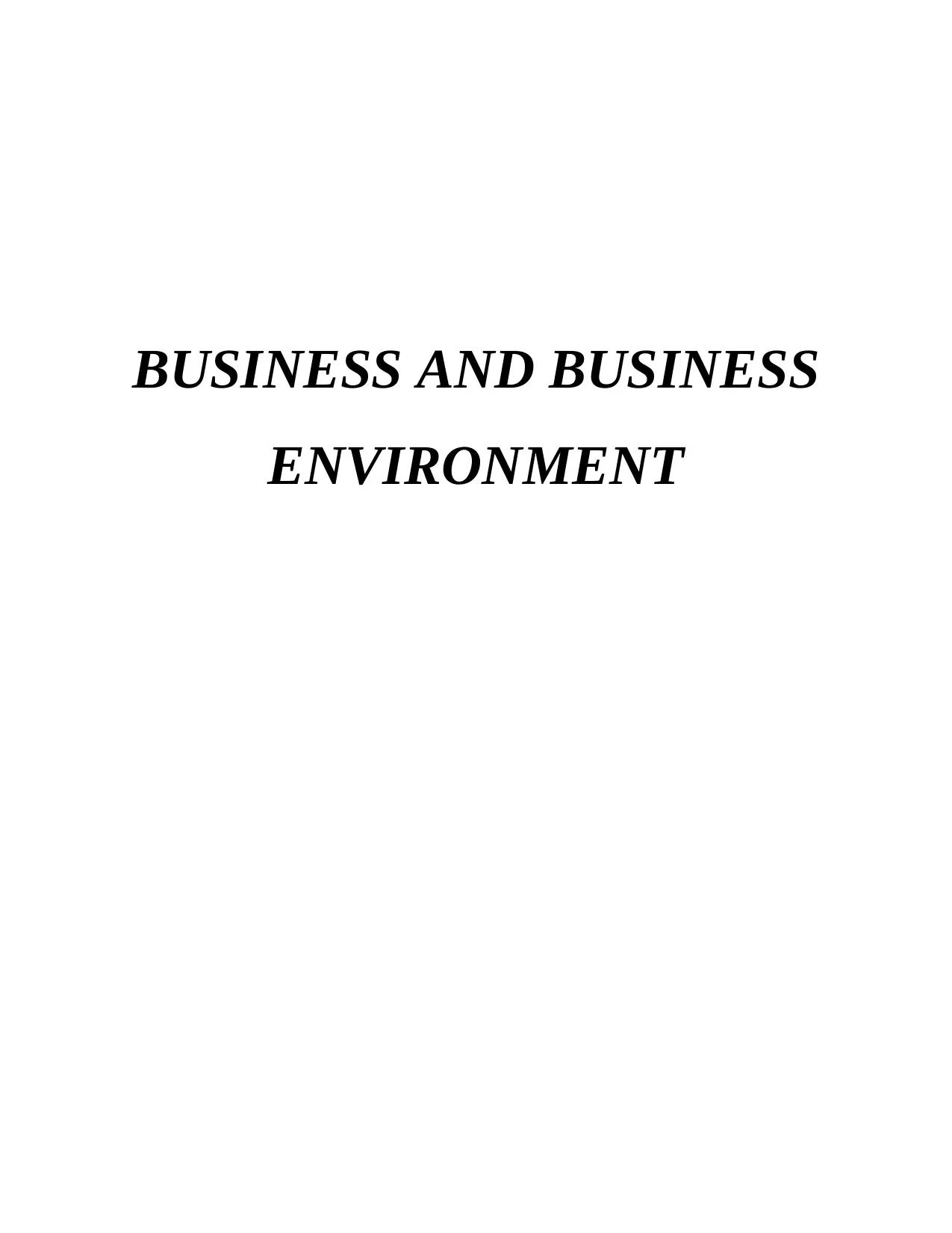
BUSINESS AND BUSINESS
ENVIRONMENT
ENVIRONMENT
Paraphrase This Document
Need a fresh take? Get an instant paraphrase of this document with our AI Paraphraser
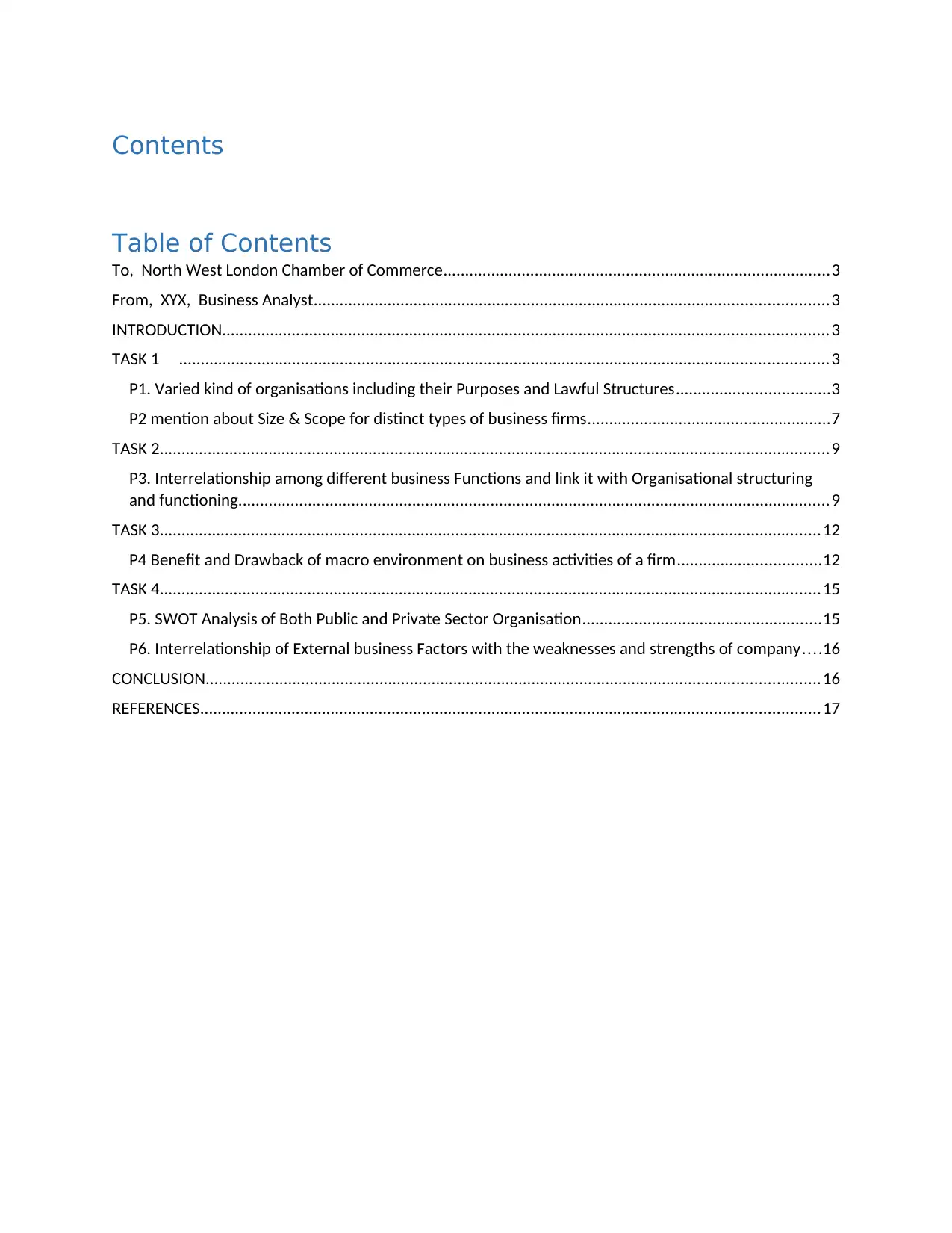
Contents
Table of Contents
To, North West London Chamber of Commerce.........................................................................................3
From, XYX, Business Analyst......................................................................................................................3
INTRODUCTION...........................................................................................................................................3
TASK 1 .....................................................................................................................................................3
P1. Varied kind of organisations including their Purposes and Lawful Structures...................................3
P2 mention about Size & Scope for distinct types of business firms........................................................7
TASK 2..........................................................................................................................................................9
P3. Interrelationship among different business Functions and link it with Organisational structuring
and functioning........................................................................................................................................9
TASK 3........................................................................................................................................................12
P4 Benefit and Drawback of macro environment on business activities of a firm.................................12
TASK 4........................................................................................................................................................15
P5. SWOT Analysis of Both Public and Private Sector Organisation.......................................................15
P6. Interrelationship of External business Factors with the weaknesses and strengths of company....16
CONCLUSION.............................................................................................................................................16
REFERENCES..............................................................................................................................................17
Table of Contents
To, North West London Chamber of Commerce.........................................................................................3
From, XYX, Business Analyst......................................................................................................................3
INTRODUCTION...........................................................................................................................................3
TASK 1 .....................................................................................................................................................3
P1. Varied kind of organisations including their Purposes and Lawful Structures...................................3
P2 mention about Size & Scope for distinct types of business firms........................................................7
TASK 2..........................................................................................................................................................9
P3. Interrelationship among different business Functions and link it with Organisational structuring
and functioning........................................................................................................................................9
TASK 3........................................................................................................................................................12
P4 Benefit and Drawback of macro environment on business activities of a firm.................................12
TASK 4........................................................................................................................................................15
P5. SWOT Analysis of Both Public and Private Sector Organisation.......................................................15
P6. Interrelationship of External business Factors with the weaknesses and strengths of company....16
CONCLUSION.............................................................................................................................................16
REFERENCES..............................................................................................................................................17
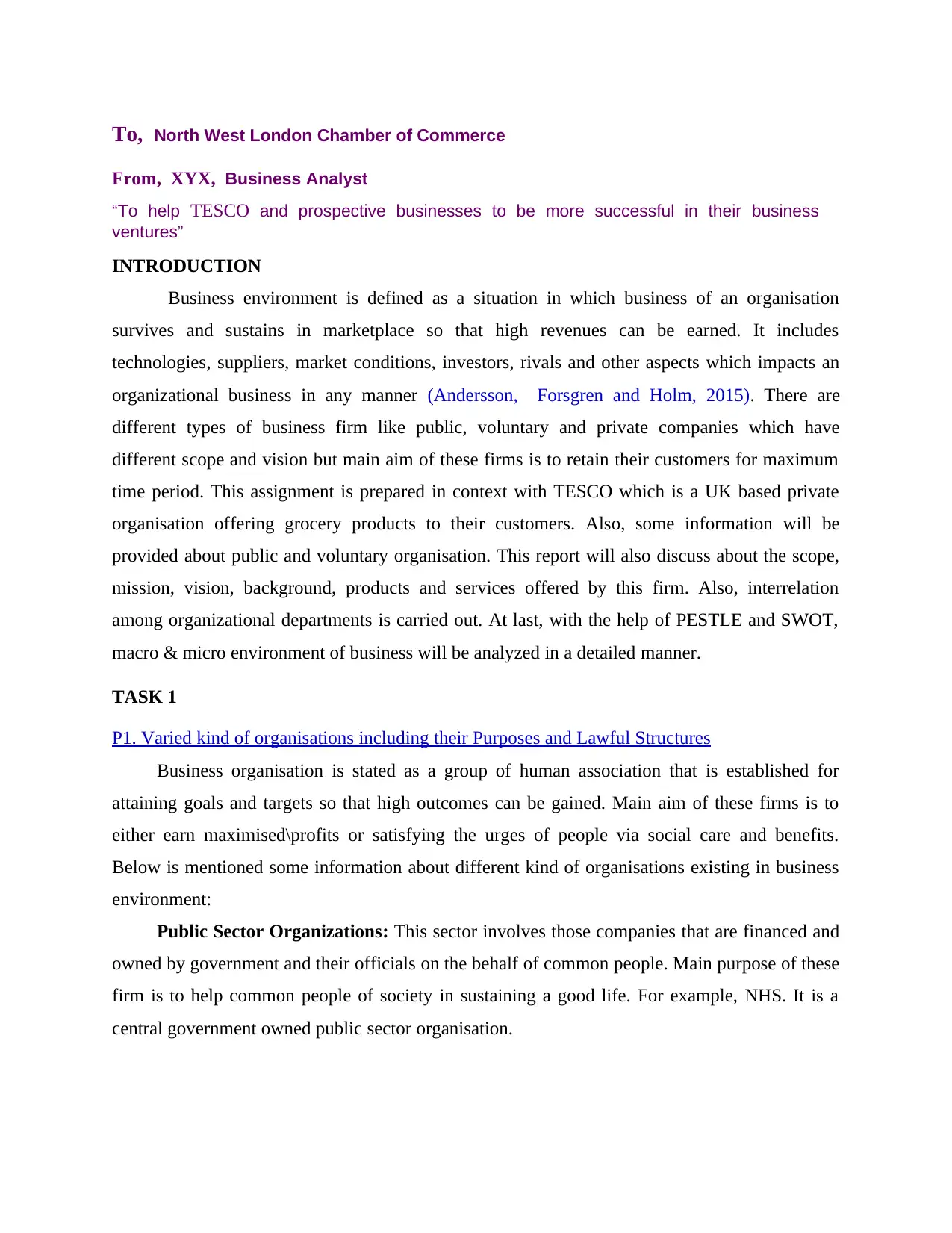
To, North West London Chamber of Commerce
From, XYX, Business Analyst
“To help TESCO and prospective businesses to be more successful in their business
ventures”
INTRODUCTION
Business environment is defined as a situation in which business of an organisation
survives and sustains in marketplace so that high revenues can be earned. It includes
technologies, suppliers, market conditions, investors, rivals and other aspects which impacts an
organizational business in any manner (Andersson, Forsgren and Holm, 2015). There are
different types of business firm like public, voluntary and private companies which have
different scope and vision but main aim of these firms is to retain their customers for maximum
time period. This assignment is prepared in context with TESCO which is a UK based private
organisation offering grocery products to their customers. Also, some information will be
provided about public and voluntary organisation. This report will also discuss about the scope,
mission, vision, background, products and services offered by this firm. Also, interrelation
among organizational departments is carried out. At last, with the help of PESTLE and SWOT,
macro & micro environment of business will be analyzed in a detailed manner.
TASK 1
P1. Varied kind of organisations including their Purposes and Lawful Structures
Business organisation is stated as a group of human association that is established for
attaining goals and targets so that high outcomes can be gained. Main aim of these firms is to
either earn maximised\profits or satisfying the urges of people via social care and benefits.
Below is mentioned some information about different kind of organisations existing in business
environment:
Public Sector Organizations: This sector involves those companies that are financed and
owned by government and their officials on the behalf of common people. Main purpose of these
firm is to help common people of society in sustaining a good life. For example, NHS. It is a
central government owned public sector organisation.
From, XYX, Business Analyst
“To help TESCO and prospective businesses to be more successful in their business
ventures”
INTRODUCTION
Business environment is defined as a situation in which business of an organisation
survives and sustains in marketplace so that high revenues can be earned. It includes
technologies, suppliers, market conditions, investors, rivals and other aspects which impacts an
organizational business in any manner (Andersson, Forsgren and Holm, 2015). There are
different types of business firm like public, voluntary and private companies which have
different scope and vision but main aim of these firms is to retain their customers for maximum
time period. This assignment is prepared in context with TESCO which is a UK based private
organisation offering grocery products to their customers. Also, some information will be
provided about public and voluntary organisation. This report will also discuss about the scope,
mission, vision, background, products and services offered by this firm. Also, interrelation
among organizational departments is carried out. At last, with the help of PESTLE and SWOT,
macro & micro environment of business will be analyzed in a detailed manner.
TASK 1
P1. Varied kind of organisations including their Purposes and Lawful Structures
Business organisation is stated as a group of human association that is established for
attaining goals and targets so that high outcomes can be gained. Main aim of these firms is to
either earn maximised\profits or satisfying the urges of people via social care and benefits.
Below is mentioned some information about different kind of organisations existing in business
environment:
Public Sector Organizations: This sector involves those companies that are financed and
owned by government and their officials on the behalf of common people. Main purpose of these
firm is to help common people of society in sustaining a good life. For example, NHS. It is a
central government owned public sector organisation.
⊘ This is a preview!⊘
Do you want full access?
Subscribe today to unlock all pages.

Trusted by 1+ million students worldwide
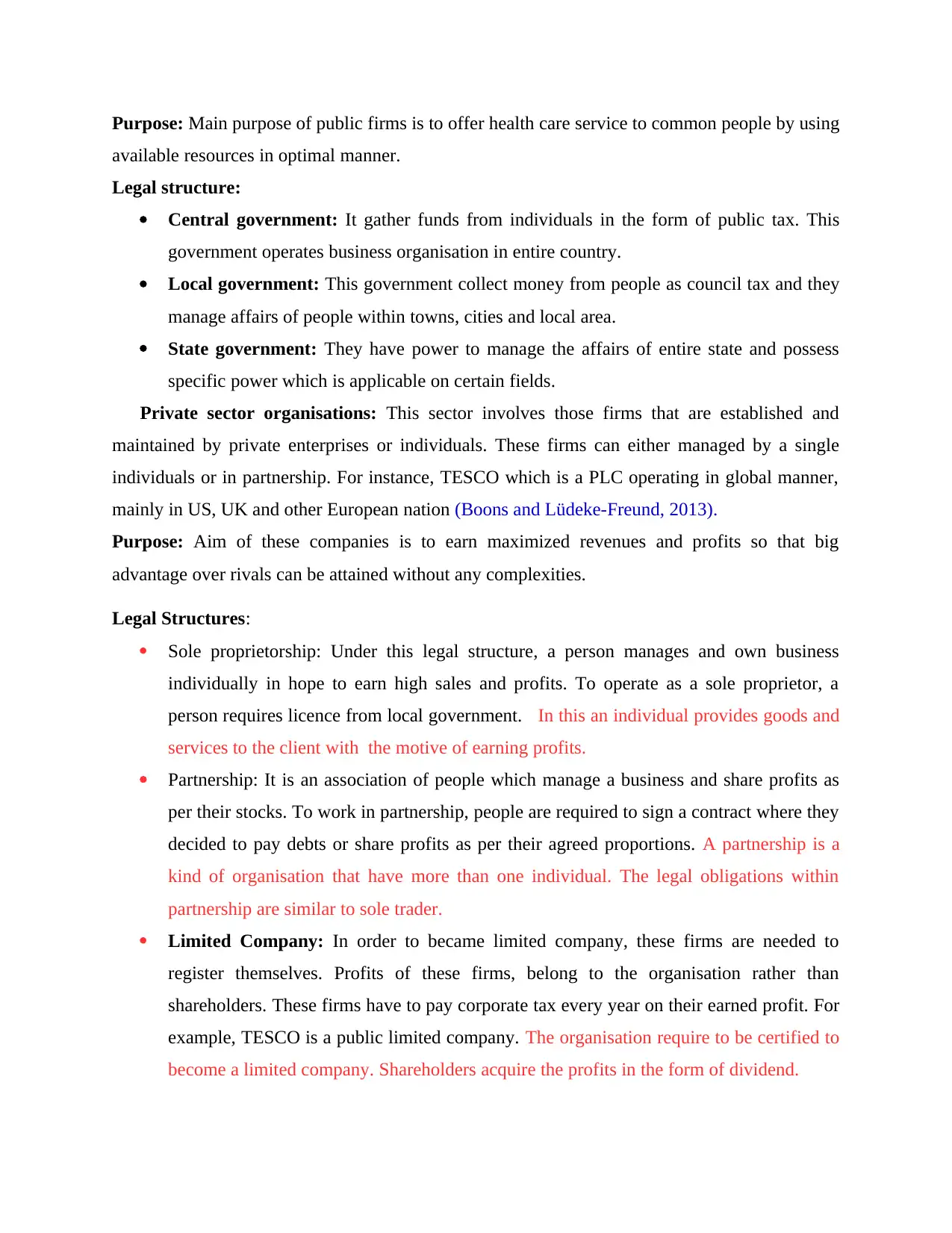
Purpose: Main purpose of public firms is to offer health care service to common people by using
available resources in optimal manner.
Legal structure:
Central government: It gather funds from individuals in the form of public tax. This
government operates business organisation in entire country.
Local government: This government collect money from people as council tax and they
manage affairs of people within towns, cities and local area.
State government: They have power to manage the affairs of entire state and possess
specific power which is applicable on certain fields.
Private sector organisations: This sector involves those firms that are established and
maintained by private enterprises or individuals. These firms can either managed by a single
individuals or in partnership. For instance, TESCO which is a PLC operating in global manner,
mainly in US, UK and other European nation (Boons and Lüdeke-Freund, 2013).
Purpose: Aim of these companies is to earn maximized revenues and profits so that big
advantage over rivals can be attained without any complexities.
Legal Structures:
Sole proprietorship: Under this legal structure, a person manages and own business
individually in hope to earn high sales and profits. To operate as a sole proprietor, a
person requires licence from local government. In this an individual provides goods and
services to the client with the motive of earning profits.
Partnership: It is an association of people which manage a business and share profits as
per their stocks. To work in partnership, people are required to sign a contract where they
decided to pay debts or share profits as per their agreed proportions. A partnership is a
kind of organisation that have more than one individual. The legal obligations within
partnership are similar to sole trader.
Limited Company: In order to became limited company, these firms are needed to
register themselves. Profits of these firms, belong to the organisation rather than
shareholders. These firms have to pay corporate tax every year on their earned profit. For
example, TESCO is a public limited company. The organisation require to be certified to
become a limited company. Shareholders acquire the profits in the form of dividend.
available resources in optimal manner.
Legal structure:
Central government: It gather funds from individuals in the form of public tax. This
government operates business organisation in entire country.
Local government: This government collect money from people as council tax and they
manage affairs of people within towns, cities and local area.
State government: They have power to manage the affairs of entire state and possess
specific power which is applicable on certain fields.
Private sector organisations: This sector involves those firms that are established and
maintained by private enterprises or individuals. These firms can either managed by a single
individuals or in partnership. For instance, TESCO which is a PLC operating in global manner,
mainly in US, UK and other European nation (Boons and Lüdeke-Freund, 2013).
Purpose: Aim of these companies is to earn maximized revenues and profits so that big
advantage over rivals can be attained without any complexities.
Legal Structures:
Sole proprietorship: Under this legal structure, a person manages and own business
individually in hope to earn high sales and profits. To operate as a sole proprietor, a
person requires licence from local government. In this an individual provides goods and
services to the client with the motive of earning profits.
Partnership: It is an association of people which manage a business and share profits as
per their stocks. To work in partnership, people are required to sign a contract where they
decided to pay debts or share profits as per their agreed proportions. A partnership is a
kind of organisation that have more than one individual. The legal obligations within
partnership are similar to sole trader.
Limited Company: In order to became limited company, these firms are needed to
register themselves. Profits of these firms, belong to the organisation rather than
shareholders. These firms have to pay corporate tax every year on their earned profit. For
example, TESCO is a public limited company. The organisation require to be certified to
become a limited company. Shareholders acquire the profits in the form of dividend.
Paraphrase This Document
Need a fresh take? Get an instant paraphrase of this document with our AI Paraphraser
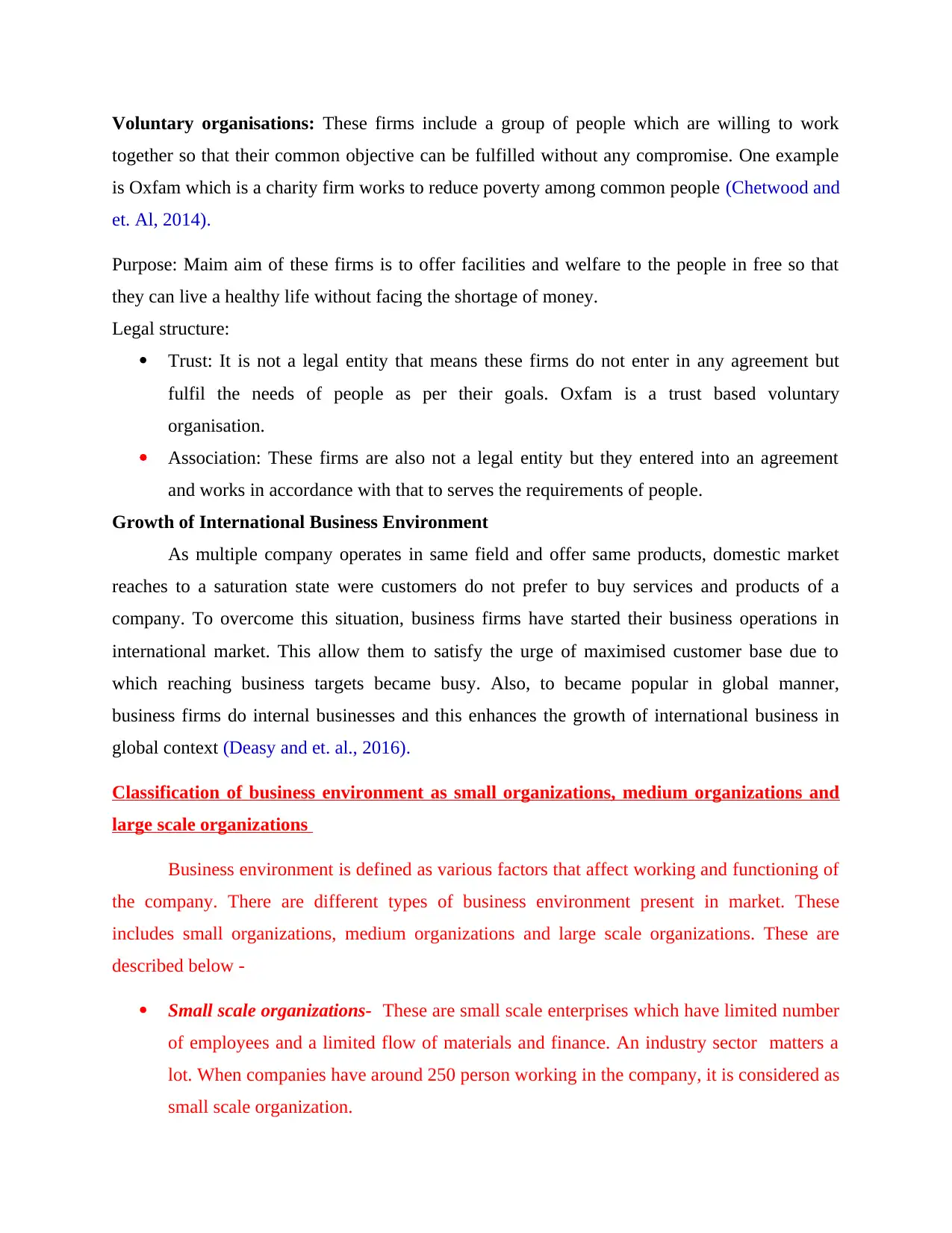
Voluntary organisations: These firms include a group of people which are willing to work
together so that their common objective can be fulfilled without any compromise. One example
is Oxfam which is a charity firm works to reduce poverty among common people (Chetwood and
et. Al, 2014).
Purpose: Maim aim of these firms is to offer facilities and welfare to the people in free so that
they can live a healthy life without facing the shortage of money.
Legal structure:
Trust: It is not a legal entity that means these firms do not enter in any agreement but
fulfil the needs of people as per their goals. Oxfam is a trust based voluntary
organisation.
Association: These firms are also not a legal entity but they entered into an agreement
and works in accordance with that to serves the requirements of people.
Growth of International Business Environment
As multiple company operates in same field and offer same products, domestic market
reaches to a saturation state were customers do not prefer to buy services and products of a
company. To overcome this situation, business firms have started their business operations in
international market. This allow them to satisfy the urge of maximised customer base due to
which reaching business targets became busy. Also, to became popular in global manner,
business firms do internal businesses and this enhances the growth of international business in
global context (Deasy and et. al., 2016).
Classification of business environment as small organizations, medium organizations and
large scale organizations
Business environment is defined as various factors that affect working and functioning of
the company. There are different types of business environment present in market. These
includes small organizations, medium organizations and large scale organizations. These are
described below -
Small scale organizations- These are small scale enterprises which have limited number
of employees and a limited flow of materials and finance. An industry sector matters a
lot. When companies have around 250 person working in the company, it is considered as
small scale organization.
together so that their common objective can be fulfilled without any compromise. One example
is Oxfam which is a charity firm works to reduce poverty among common people (Chetwood and
et. Al, 2014).
Purpose: Maim aim of these firms is to offer facilities and welfare to the people in free so that
they can live a healthy life without facing the shortage of money.
Legal structure:
Trust: It is not a legal entity that means these firms do not enter in any agreement but
fulfil the needs of people as per their goals. Oxfam is a trust based voluntary
organisation.
Association: These firms are also not a legal entity but they entered into an agreement
and works in accordance with that to serves the requirements of people.
Growth of International Business Environment
As multiple company operates in same field and offer same products, domestic market
reaches to a saturation state were customers do not prefer to buy services and products of a
company. To overcome this situation, business firms have started their business operations in
international market. This allow them to satisfy the urge of maximised customer base due to
which reaching business targets became busy. Also, to became popular in global manner,
business firms do internal businesses and this enhances the growth of international business in
global context (Deasy and et. al., 2016).
Classification of business environment as small organizations, medium organizations and
large scale organizations
Business environment is defined as various factors that affect working and functioning of
the company. There are different types of business environment present in market. These
includes small organizations, medium organizations and large scale organizations. These are
described below -
Small scale organizations- These are small scale enterprises which have limited number
of employees and a limited flow of materials and finance. An industry sector matters a
lot. When companies have around 250 person working in the company, it is considered as
small scale organization.
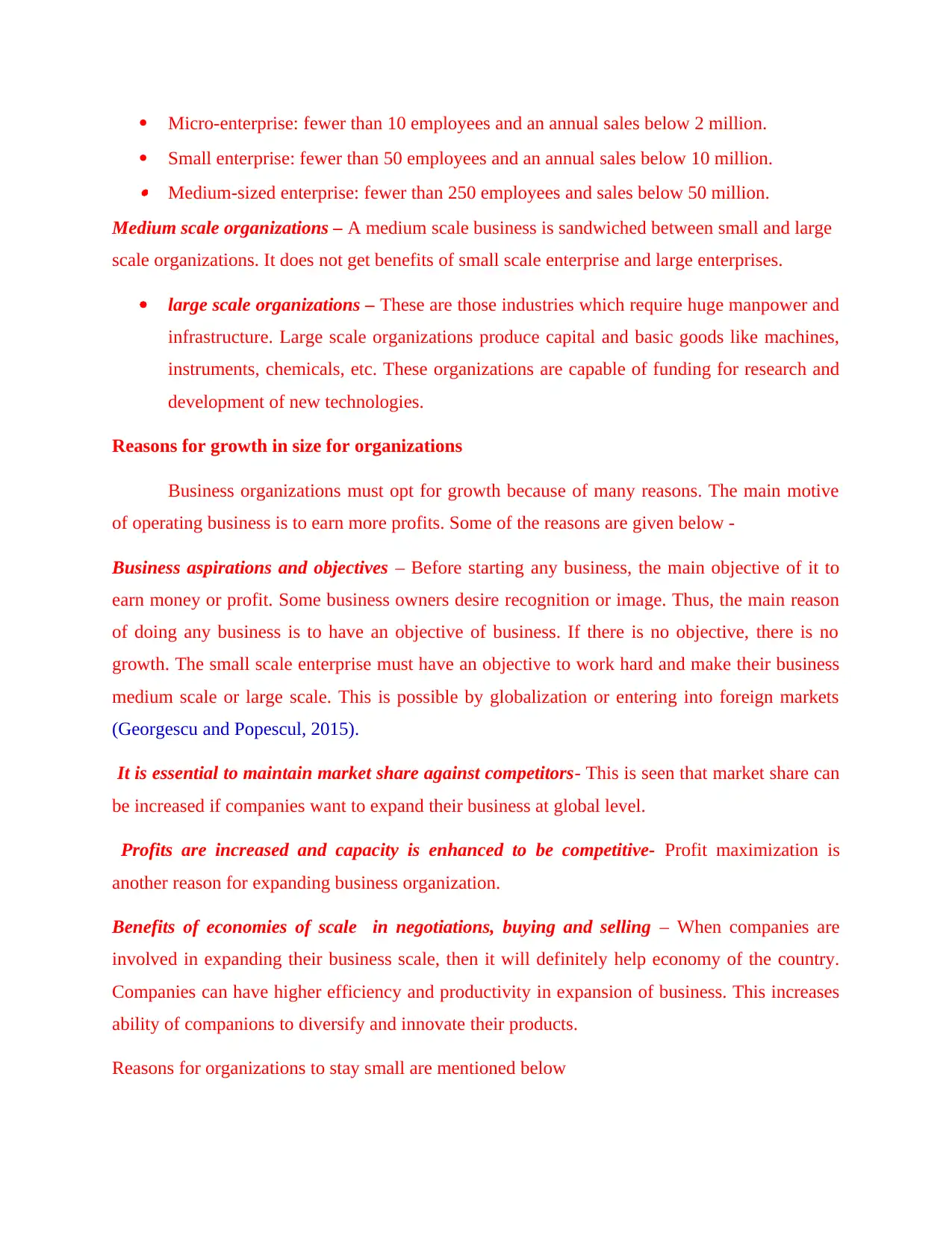
Micro-enterprise: fewer than 10 employees and an annual sales below 2 million.
Small enterprise: fewer than 50 employees and an annual sales below 10 million. Medium-sized enterprise: fewer than 250 employees and sales below 50 million.
Medium scale organizations – A medium scale business is sandwiched between small and large
scale organizations. It does not get benefits of small scale enterprise and large enterprises.
large scale organizations – These are those industries which require huge manpower and
infrastructure. Large scale organizations produce capital and basic goods like machines,
instruments, chemicals, etc. These organizations are capable of funding for research and
development of new technologies.
Reasons for growth in size for organizations
Business organizations must opt for growth because of many reasons. The main motive
of operating business is to earn more profits. Some of the reasons are given below -
Business aspirations and objectives – Before starting any business, the main objective of it to
earn money or profit. Some business owners desire recognition or image. Thus, the main reason
of doing any business is to have an objective of business. If there is no objective, there is no
growth. The small scale enterprise must have an objective to work hard and make their business
medium scale or large scale. This is possible by globalization or entering into foreign markets
(Georgescu and Popescul, 2015).
It is essential to maintain market share against competitors- This is seen that market share can
be increased if companies want to expand their business at global level.
Profits are increased and capacity is enhanced to be competitive- Profit maximization is
another reason for expanding business organization.
Benefits of economies of scale in negotiations, buying and selling – When companies are
involved in expanding their business scale, then it will definitely help economy of the country.
Companies can have higher efficiency and productivity in expansion of business. This increases
ability of companions to diversify and innovate their products.
Reasons for organizations to stay small are mentioned below
Small enterprise: fewer than 50 employees and an annual sales below 10 million. Medium-sized enterprise: fewer than 250 employees and sales below 50 million.
Medium scale organizations – A medium scale business is sandwiched between small and large
scale organizations. It does not get benefits of small scale enterprise and large enterprises.
large scale organizations – These are those industries which require huge manpower and
infrastructure. Large scale organizations produce capital and basic goods like machines,
instruments, chemicals, etc. These organizations are capable of funding for research and
development of new technologies.
Reasons for growth in size for organizations
Business organizations must opt for growth because of many reasons. The main motive
of operating business is to earn more profits. Some of the reasons are given below -
Business aspirations and objectives – Before starting any business, the main objective of it to
earn money or profit. Some business owners desire recognition or image. Thus, the main reason
of doing any business is to have an objective of business. If there is no objective, there is no
growth. The small scale enterprise must have an objective to work hard and make their business
medium scale or large scale. This is possible by globalization or entering into foreign markets
(Georgescu and Popescul, 2015).
It is essential to maintain market share against competitors- This is seen that market share can
be increased if companies want to expand their business at global level.
Profits are increased and capacity is enhanced to be competitive- Profit maximization is
another reason for expanding business organization.
Benefits of economies of scale in negotiations, buying and selling – When companies are
involved in expanding their business scale, then it will definitely help economy of the country.
Companies can have higher efficiency and productivity in expansion of business. This increases
ability of companions to diversify and innovate their products.
Reasons for organizations to stay small are mentioned below
⊘ This is a preview!⊘
Do you want full access?
Subscribe today to unlock all pages.

Trusted by 1+ million students worldwide
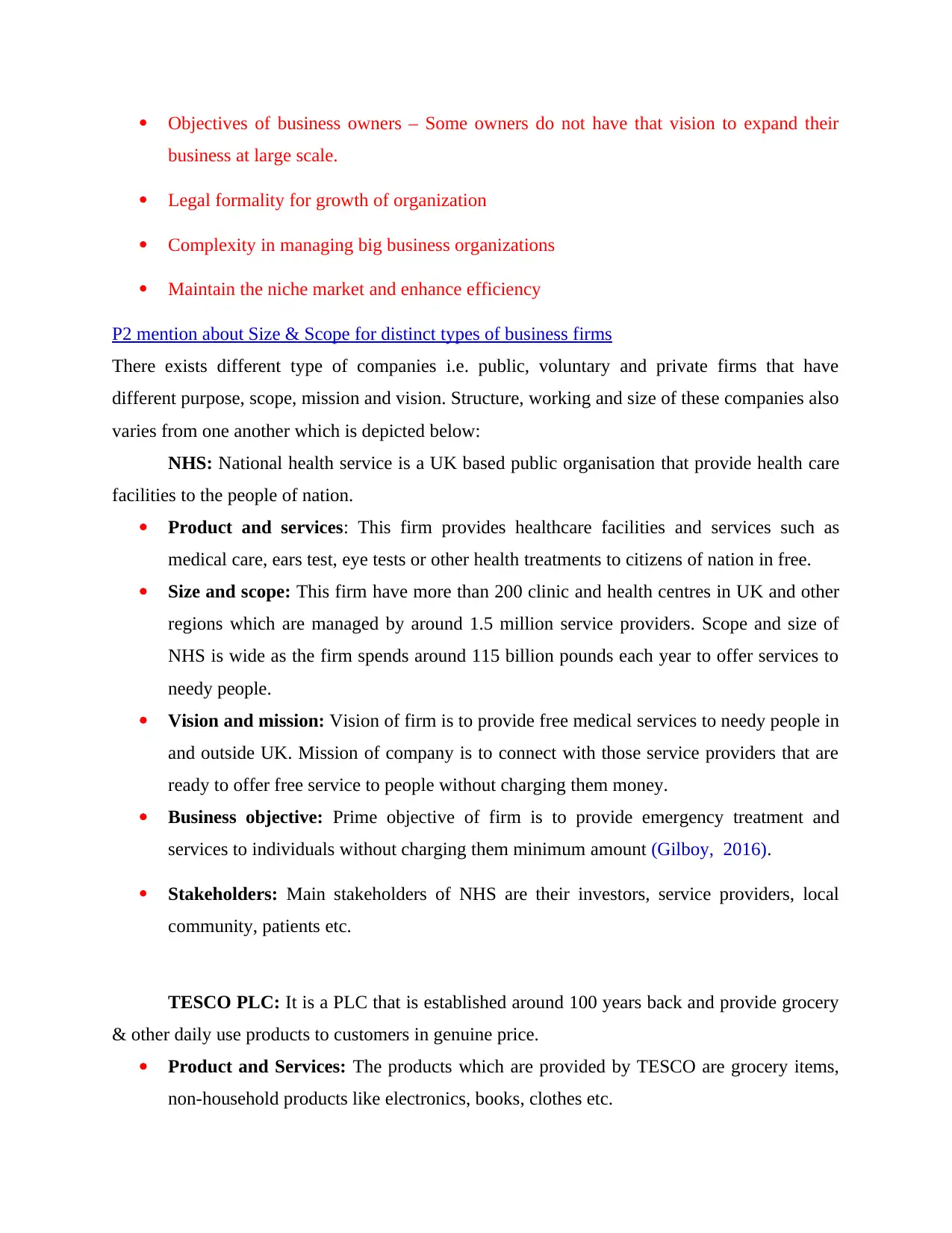
Objectives of business owners – Some owners do not have that vision to expand their
business at large scale.
Legal formality for growth of organization
Complexity in managing big business organizations
Maintain the niche market and enhance efficiency
P2 mention about Size & Scope for distinct types of business firms
There exists different type of companies i.e. public, voluntary and private firms that have
different purpose, scope, mission and vision. Structure, working and size of these companies also
varies from one another which is depicted below:
NHS: National health service is a UK based public organisation that provide health care
facilities to the people of nation.
Product and services: This firm provides healthcare facilities and services such as
medical care, ears test, eye tests or other health treatments to citizens of nation in free.
Size and scope: This firm have more than 200 clinic and health centres in UK and other
regions which are managed by around 1.5 million service providers. Scope and size of
NHS is wide as the firm spends around 115 billion pounds each year to offer services to
needy people.
Vision and mission: Vision of firm is to provide free medical services to needy people in
and outside UK. Mission of company is to connect with those service providers that are
ready to offer free service to people without charging them money.
Business objective: Prime objective of firm is to provide emergency treatment and
services to individuals without charging them minimum amount (Gilboy, 2016).
Stakeholders: Main stakeholders of NHS are their investors, service providers, local
community, patients etc.
TESCO PLC: It is a PLC that is established around 100 years back and provide grocery
& other daily use products to customers in genuine price.
Product and Services: The products which are provided by TESCO are grocery items,
non-household products like electronics, books, clothes etc.
business at large scale.
Legal formality for growth of organization
Complexity in managing big business organizations
Maintain the niche market and enhance efficiency
P2 mention about Size & Scope for distinct types of business firms
There exists different type of companies i.e. public, voluntary and private firms that have
different purpose, scope, mission and vision. Structure, working and size of these companies also
varies from one another which is depicted below:
NHS: National health service is a UK based public organisation that provide health care
facilities to the people of nation.
Product and services: This firm provides healthcare facilities and services such as
medical care, ears test, eye tests or other health treatments to citizens of nation in free.
Size and scope: This firm have more than 200 clinic and health centres in UK and other
regions which are managed by around 1.5 million service providers. Scope and size of
NHS is wide as the firm spends around 115 billion pounds each year to offer services to
needy people.
Vision and mission: Vision of firm is to provide free medical services to needy people in
and outside UK. Mission of company is to connect with those service providers that are
ready to offer free service to people without charging them money.
Business objective: Prime objective of firm is to provide emergency treatment and
services to individuals without charging them minimum amount (Gilboy, 2016).
Stakeholders: Main stakeholders of NHS are their investors, service providers, local
community, patients etc.
TESCO PLC: It is a PLC that is established around 100 years back and provide grocery
& other daily use products to customers in genuine price.
Product and Services: The products which are provided by TESCO are grocery items,
non-household products like electronics, books, clothes etc.
Paraphrase This Document
Need a fresh take? Get an instant paraphrase of this document with our AI Paraphraser
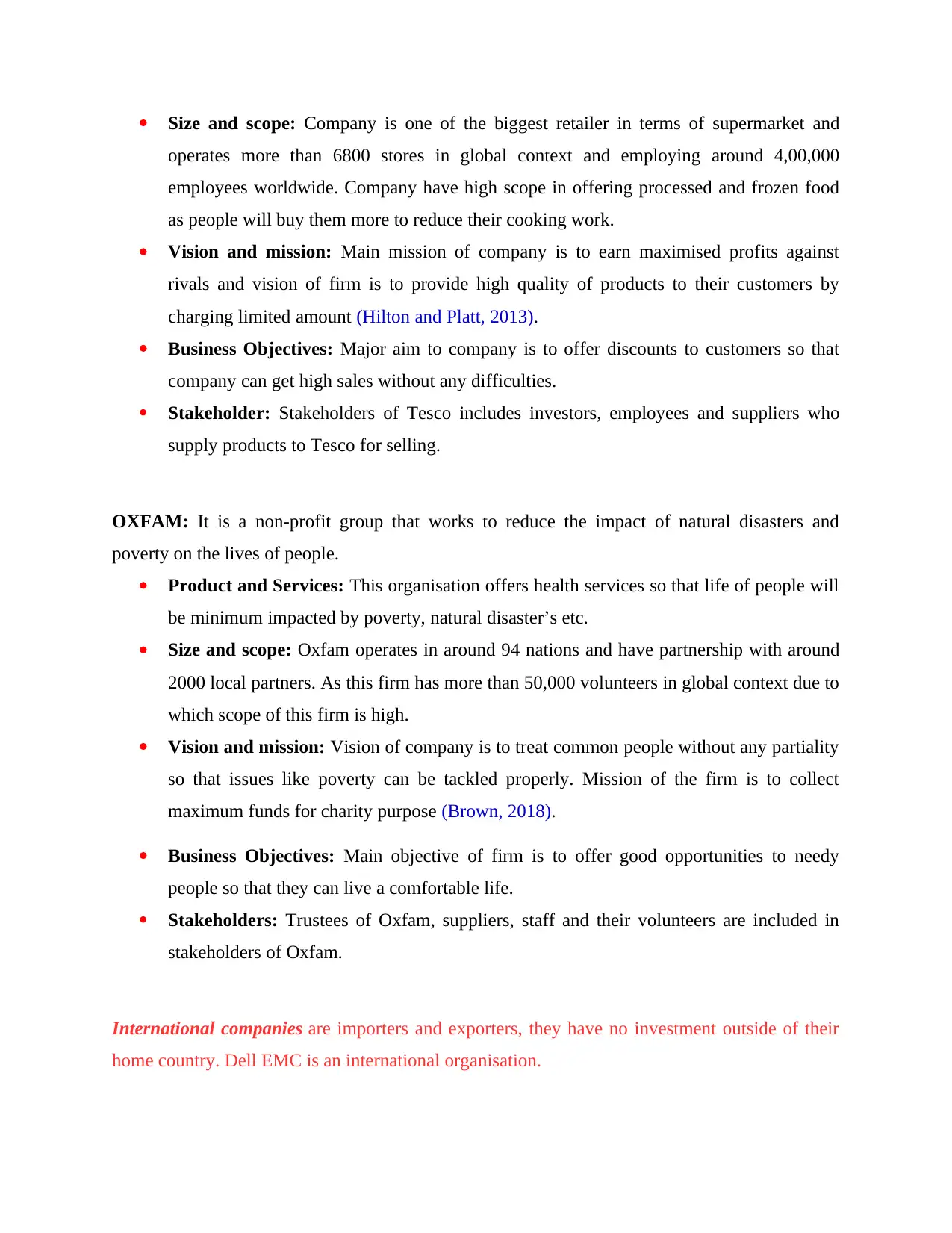
Size and scope: Company is one of the biggest retailer in terms of supermarket and
operates more than 6800 stores in global context and employing around 4,00,000
employees worldwide. Company have high scope in offering processed and frozen food
as people will buy them more to reduce their cooking work.
Vision and mission: Main mission of company is to earn maximised profits against
rivals and vision of firm is to provide high quality of products to their customers by
charging limited amount (Hilton and Platt, 2013).
Business Objectives: Major aim to company is to offer discounts to customers so that
company can get high sales without any difficulties.
Stakeholder: Stakeholders of Tesco includes investors, employees and suppliers who
supply products to Tesco for selling.
OXFAM: It is a non-profit group that works to reduce the impact of natural disasters and
poverty on the lives of people.
Product and Services: This organisation offers health services so that life of people will
be minimum impacted by poverty, natural disaster’s etc.
Size and scope: Oxfam operates in around 94 nations and have partnership with around
2000 local partners. As this firm has more than 50,000 volunteers in global context due to
which scope of this firm is high.
Vision and mission: Vision of company is to treat common people without any partiality
so that issues like poverty can be tackled properly. Mission of the firm is to collect
maximum funds for charity purpose (Brown, 2018).
Business Objectives: Main objective of firm is to offer good opportunities to needy
people so that they can live a comfortable life.
Stakeholders: Trustees of Oxfam, suppliers, staff and their volunteers are included in
stakeholders of Oxfam.
International companies are importers and exporters, they have no investment outside of their
home country. Dell EMC is an international organisation.
operates more than 6800 stores in global context and employing around 4,00,000
employees worldwide. Company have high scope in offering processed and frozen food
as people will buy them more to reduce their cooking work.
Vision and mission: Main mission of company is to earn maximised profits against
rivals and vision of firm is to provide high quality of products to their customers by
charging limited amount (Hilton and Platt, 2013).
Business Objectives: Major aim to company is to offer discounts to customers so that
company can get high sales without any difficulties.
Stakeholder: Stakeholders of Tesco includes investors, employees and suppliers who
supply products to Tesco for selling.
OXFAM: It is a non-profit group that works to reduce the impact of natural disasters and
poverty on the lives of people.
Product and Services: This organisation offers health services so that life of people will
be minimum impacted by poverty, natural disaster’s etc.
Size and scope: Oxfam operates in around 94 nations and have partnership with around
2000 local partners. As this firm has more than 50,000 volunteers in global context due to
which scope of this firm is high.
Vision and mission: Vision of company is to treat common people without any partiality
so that issues like poverty can be tackled properly. Mission of the firm is to collect
maximum funds for charity purpose (Brown, 2018).
Business Objectives: Main objective of firm is to offer good opportunities to needy
people so that they can live a comfortable life.
Stakeholders: Trustees of Oxfam, suppliers, staff and their volunteers are included in
stakeholders of Oxfam.
International companies are importers and exporters, they have no investment outside of their
home country. Dell EMC is an international organisation.
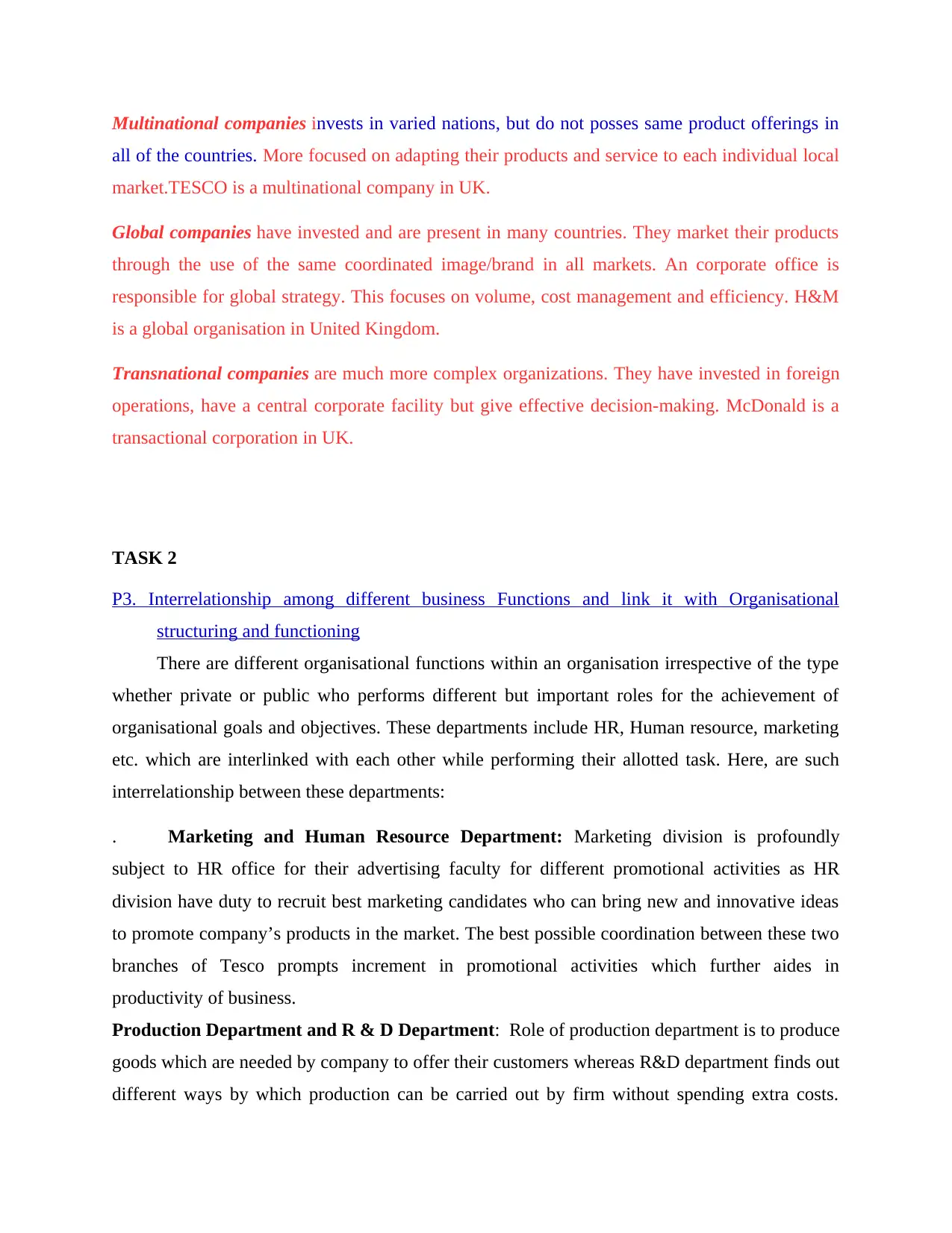
Multinational companies invests in varied nations, but do not posses same product offerings in
all of the countries. More focused on adapting their products and service to each individual local
market.TESCO is a multinational company in UK.
Global companies have invested and are present in many countries. They market their products
through the use of the same coordinated image/brand in all markets. An corporate office is
responsible for global strategy. This focuses on volume, cost management and efficiency. H&M
is a global organisation in United Kingdom.
Transnational companies are much more complex organizations. They have invested in foreign
operations, have a central corporate facility but give effective decision-making. McDonald is a
transactional corporation in UK.
TASK 2
P3. Interrelationship among different business Functions and link it with Organisational
structuring and functioning
There are different organisational functions within an organisation irrespective of the type
whether private or public who performs different but important roles for the achievement of
organisational goals and objectives. These departments include HR, Human resource, marketing
etc. which are interlinked with each other while performing their allotted task. Here, are such
interrelationship between these departments:
. Marketing and Human Resource Department: Marketing division is profoundly
subject to HR office for their advertising faculty for different promotional activities as HR
division have duty to recruit best marketing candidates who can bring new and innovative ideas
to promote company’s products in the market. The best possible coordination between these two
branches of Tesco prompts increment in promotional activities which further aides in
productivity of business.
Production Department and R & D Department: Role of production department is to produce
goods which are needed by company to offer their customers whereas R&D department finds out
different ways by which production can be carried out by firm without spending extra costs.
all of the countries. More focused on adapting their products and service to each individual local
market.TESCO is a multinational company in UK.
Global companies have invested and are present in many countries. They market their products
through the use of the same coordinated image/brand in all markets. An corporate office is
responsible for global strategy. This focuses on volume, cost management and efficiency. H&M
is a global organisation in United Kingdom.
Transnational companies are much more complex organizations. They have invested in foreign
operations, have a central corporate facility but give effective decision-making. McDonald is a
transactional corporation in UK.
TASK 2
P3. Interrelationship among different business Functions and link it with Organisational
structuring and functioning
There are different organisational functions within an organisation irrespective of the type
whether private or public who performs different but important roles for the achievement of
organisational goals and objectives. These departments include HR, Human resource, marketing
etc. which are interlinked with each other while performing their allotted task. Here, are such
interrelationship between these departments:
. Marketing and Human Resource Department: Marketing division is profoundly
subject to HR office for their advertising faculty for different promotional activities as HR
division have duty to recruit best marketing candidates who can bring new and innovative ideas
to promote company’s products in the market. The best possible coordination between these two
branches of Tesco prompts increment in promotional activities which further aides in
productivity of business.
Production Department and R & D Department: Role of production department is to produce
goods which are needed by company to offer their customers whereas R&D department finds out
different ways by which production can be carried out by firm without spending extra costs.
⊘ This is a preview!⊘
Do you want full access?
Subscribe today to unlock all pages.

Trusted by 1+ million students worldwide
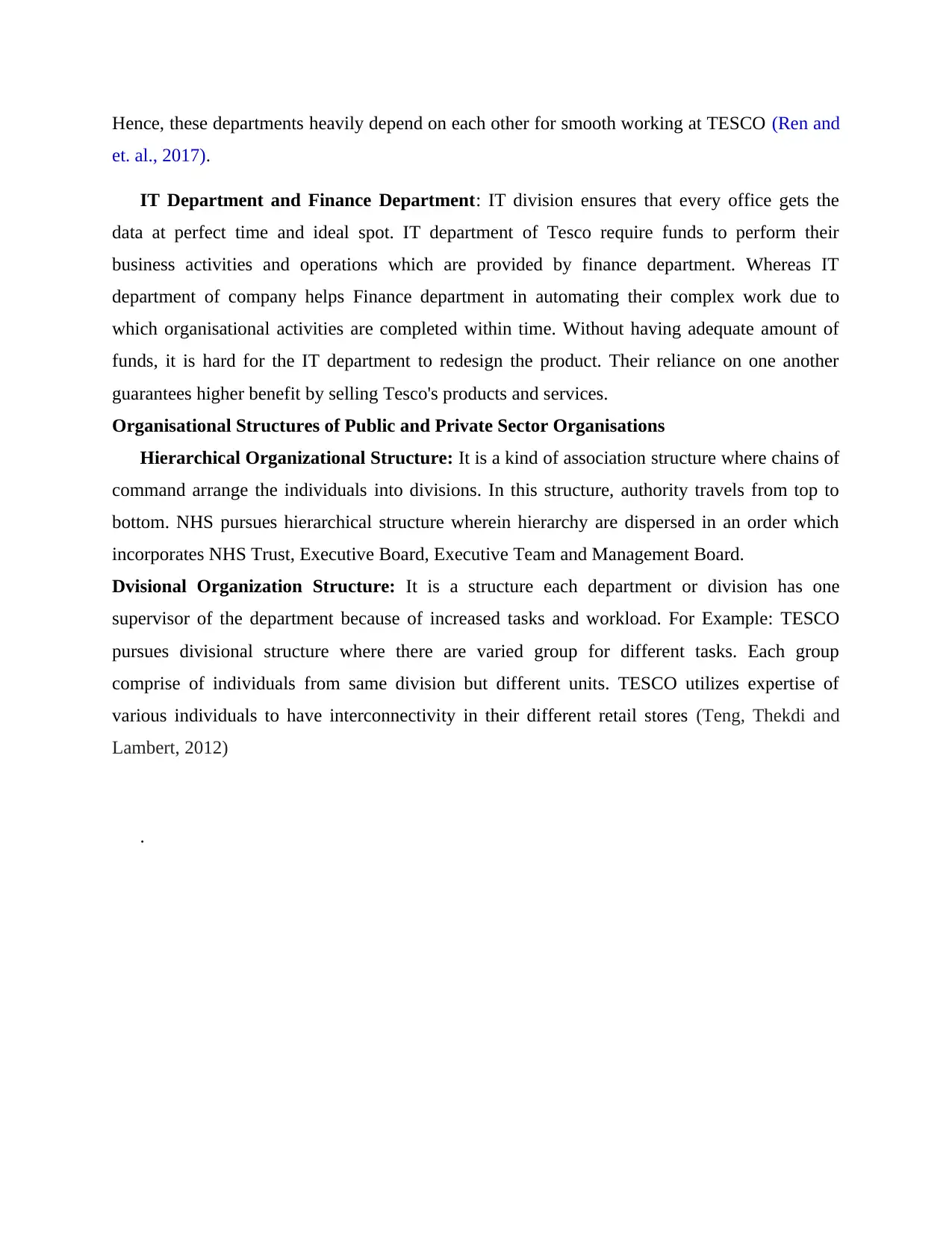
Hence, these departments heavily depend on each other for smooth working at TESCO (Ren and
et. al., 2017).
IT Department and Finance Department: IT division ensures that every office gets the
data at perfect time and ideal spot. IT department of Tesco require funds to perform their
business activities and operations which are provided by finance department. Whereas IT
department of company helps Finance department in automating their complex work due to
which organisational activities are completed within time. Without having adequate amount of
funds, it is hard for the IT department to redesign the product. Their reliance on one another
guarantees higher benefit by selling Tesco's products and services.
Organisational Structures of Public and Private Sector Organisations
Hierarchical Organizational Structure: It is a kind of association structure where chains of
command arrange the individuals into divisions. In this structure, authority travels from top to
bottom. NHS pursues hierarchical structure wherein hierarchy are dispersed in an order which
incorporates NHS Trust, Executive Board, Executive Team and Management Board.
Dvisional Organization Structure: It is a structure each department or division has one
supervisor of the department because of increased tasks and workload. For Example: TESCO
pursues divisional structure where there are varied group for different tasks. Each group
comprise of individuals from same division but different units. TESCO utilizes expertise of
various individuals to have interconnectivity in their different retail stores (Teng, Thekdi and
Lambert, 2012)
.
et. al., 2017).
IT Department and Finance Department: IT division ensures that every office gets the
data at perfect time and ideal spot. IT department of Tesco require funds to perform their
business activities and operations which are provided by finance department. Whereas IT
department of company helps Finance department in automating their complex work due to
which organisational activities are completed within time. Without having adequate amount of
funds, it is hard for the IT department to redesign the product. Their reliance on one another
guarantees higher benefit by selling Tesco's products and services.
Organisational Structures of Public and Private Sector Organisations
Hierarchical Organizational Structure: It is a kind of association structure where chains of
command arrange the individuals into divisions. In this structure, authority travels from top to
bottom. NHS pursues hierarchical structure wherein hierarchy are dispersed in an order which
incorporates NHS Trust, Executive Board, Executive Team and Management Board.
Dvisional Organization Structure: It is a structure each department or division has one
supervisor of the department because of increased tasks and workload. For Example: TESCO
pursues divisional structure where there are varied group for different tasks. Each group
comprise of individuals from same division but different units. TESCO utilizes expertise of
various individuals to have interconnectivity in their different retail stores (Teng, Thekdi and
Lambert, 2012)
.
Paraphrase This Document
Need a fresh take? Get an instant paraphrase of this document with our AI Paraphraser
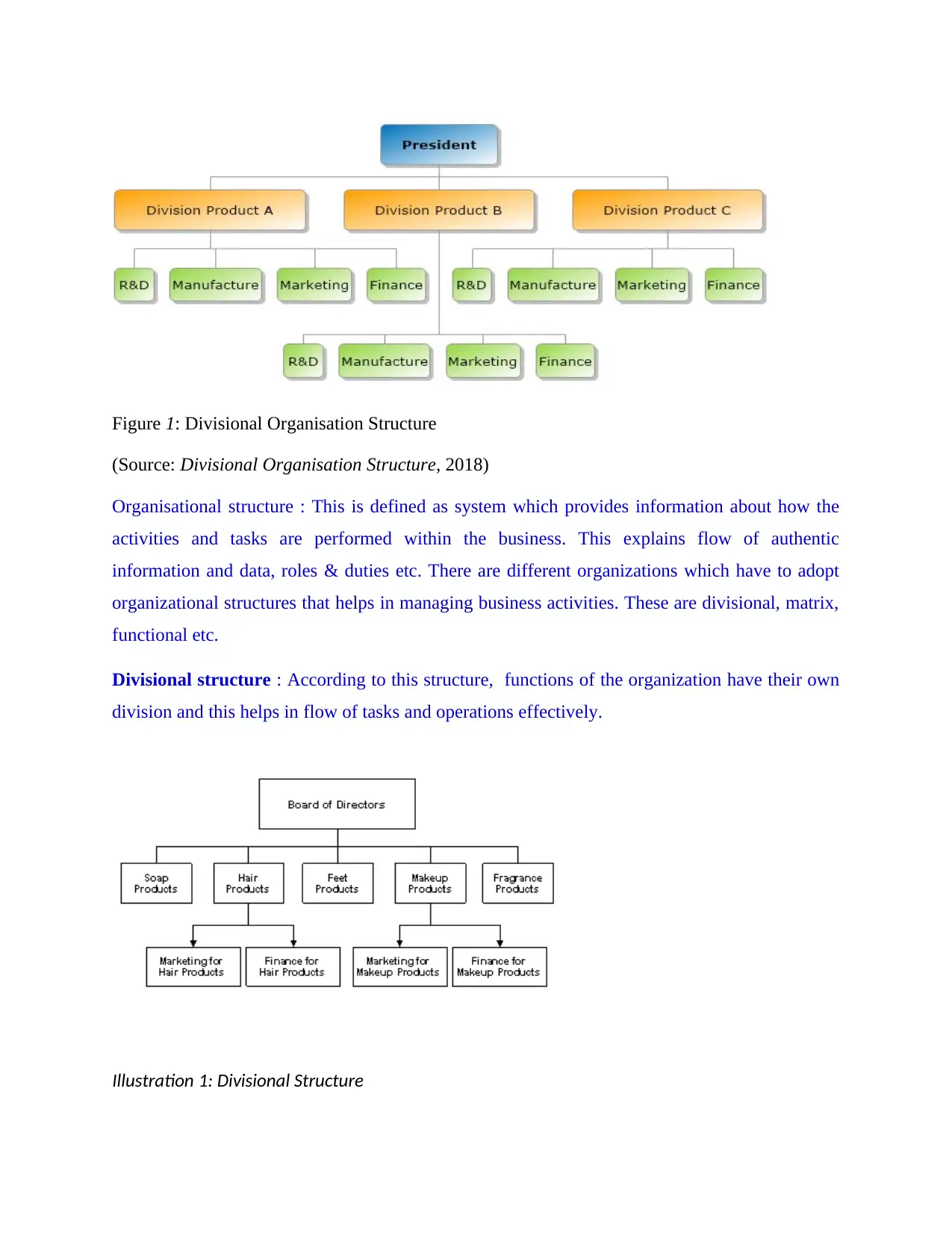
Figure 1: Divisional Organisation Structure
(Source: Divisional Organisation Structure, 2018)
Organisational structure : This is defined as system which provides information about how the
activities and tasks are performed within the business. This explains flow of authentic
information and data, roles & duties etc. There are different organizations which have to adopt
organizational structures that helps in managing business activities. These are divisional, matrix,
functional etc.
Divisional structure : According to this structure, functions of the organization have their own
division and this helps in flow of tasks and operations effectively.
Illustration 1: Divisional Structure
(Source: Divisional Organisation Structure, 2018)
Organisational structure : This is defined as system which provides information about how the
activities and tasks are performed within the business. This explains flow of authentic
information and data, roles & duties etc. There are different organizations which have to adopt
organizational structures that helps in managing business activities. These are divisional, matrix,
functional etc.
Divisional structure : According to this structure, functions of the organization have their own
division and this helps in flow of tasks and operations effectively.
Illustration 1: Divisional Structure
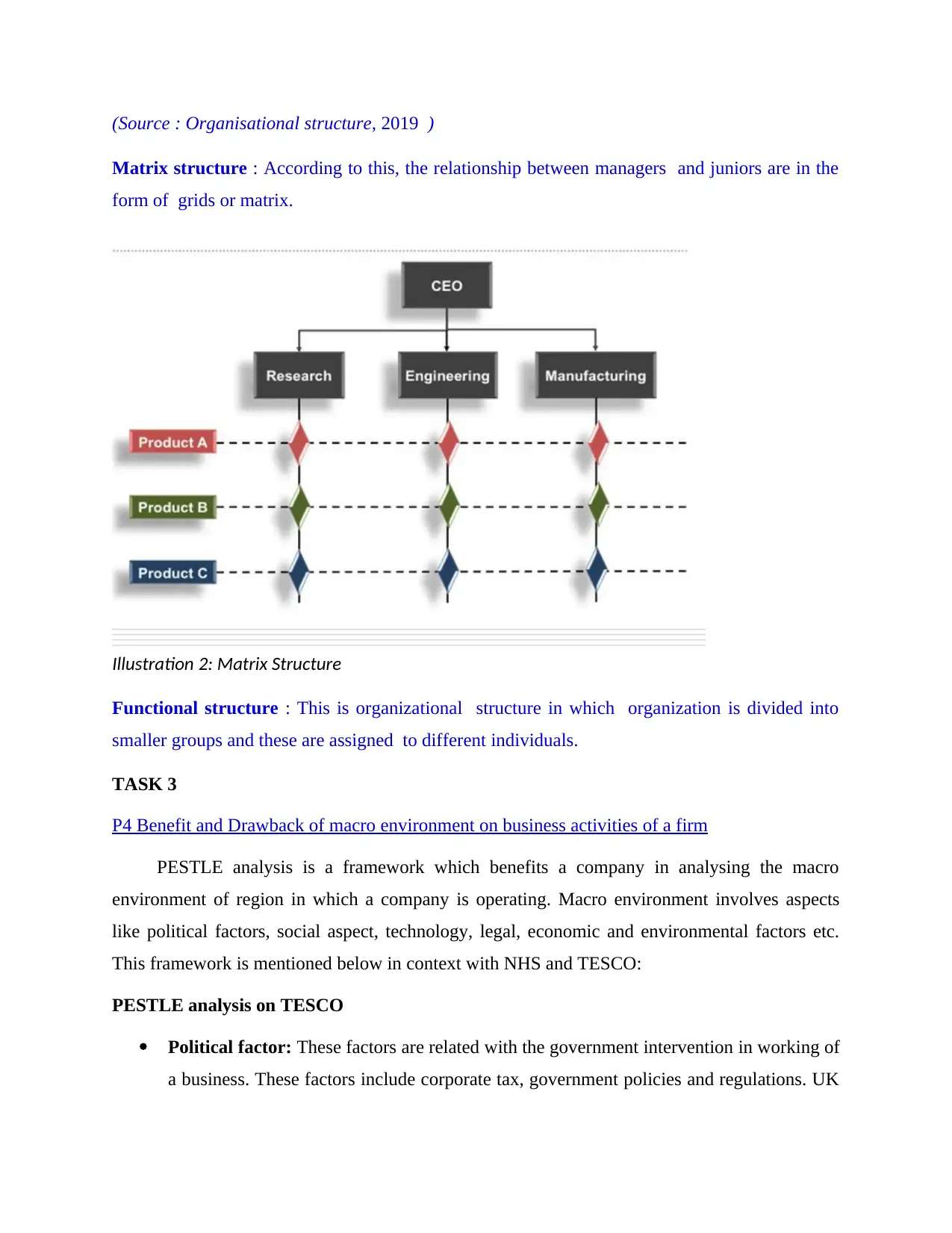
(Source : Organisational structure, 2019 )
Matrix structure : According to this, the relationship between managers and juniors are in the
form of grids or matrix.
Illustration 2: Matrix Structure
Functional structure : This is organizational structure in which organization is divided into
smaller groups and these are assigned to different individuals.
TASK 3
P4 Benefit and Drawback of macro environment on business activities of a firm
PESTLE analysis is a framework which benefits a company in analysing the macro
environment of region in which a company is operating. Macro environment involves aspects
like political factors, social aspect, technology, legal, economic and environmental factors etc.
This framework is mentioned below in context with NHS and TESCO:
PESTLE analysis on TESCO
Political factor: These factors are related with the government intervention in working of
a business. These factors include corporate tax, government policies and regulations. UK
Matrix structure : According to this, the relationship between managers and juniors are in the
form of grids or matrix.
Illustration 2: Matrix Structure
Functional structure : This is organizational structure in which organization is divided into
smaller groups and these are assigned to different individuals.
TASK 3
P4 Benefit and Drawback of macro environment on business activities of a firm
PESTLE analysis is a framework which benefits a company in analysing the macro
environment of region in which a company is operating. Macro environment involves aspects
like political factors, social aspect, technology, legal, economic and environmental factors etc.
This framework is mentioned below in context with NHS and TESCO:
PESTLE analysis on TESCO
Political factor: These factors are related with the government intervention in working of
a business. These factors include corporate tax, government policies and regulations. UK
⊘ This is a preview!⊘
Do you want full access?
Subscribe today to unlock all pages.

Trusted by 1+ million students worldwide
1 out of 19
Related Documents
Your All-in-One AI-Powered Toolkit for Academic Success.
+13062052269
info@desklib.com
Available 24*7 on WhatsApp / Email
![[object Object]](/_next/static/media/star-bottom.7253800d.svg)
Unlock your academic potential
Copyright © 2020–2025 A2Z Services. All Rights Reserved. Developed and managed by ZUCOL.





